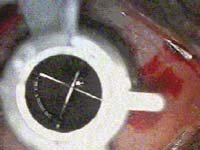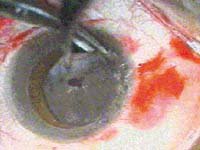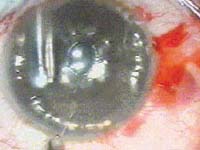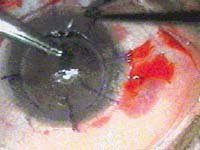Deep anterior lamellar keratoplasty more difficult, less invasive than PKP
After 5 years, patients in a retrospective series showed no graft failure, had fast recovery and few complications.
SOUTHEND ON SEA, England – Deep anterior lamellar keratoplasty can be a safe and effective alternative to penetrating keratoplasty for the management of keratoconus, according to a study conducted here.
DALK: a less invasive procedure |
|
|
Deep anterior lamellar keratoplasty (DALK) is still fairly new to many surgeons in Europe, said Mona Khandwala, FRCS, of the Southend Hospital here in Essex, England. She and colleagues performed a retrospective study to assess their results with the procedure.
Dr. Khandwala enumerated some of the advantages of DALK: “It is a nonpenetrating surgery. Endothelial rejection is eliminated. It shows quicker rehabilitation, not only because of lower astigmatism but also because of early suture removals. There is minimal reduction in endothelial cell density with time, and it also shows reduced ocular hypertension, probably because of short-term steroid usage,” she said.
“We are comparing this to a penetrating keratoplasty (PKP) where you go right through the cornea of the recipient, remove a corneal button and replace it with a full-thickness corneal button from a donor eye,” Ms. Khandwala continued.
On the negative side, DALK is a more difficult procedure than PKP and takes twice the amount of time, she said. The surgeon must dissect the layers of the recipient cornea, sparing Descemet’s membrane and the endothelium and thus leaving the anterior chamber intact. Generally, if Descemet’s is penetrated, a standard PKP must be performed.
Quicker visual recovery
Ms. Khandwala and colleagues performed a retrospective analysis of results in 17 patients: seven women and 10 men, 24 to 46 years of age (mean age 32.4 years). Follow-up was at 1, 3, 6 and 12 weeks and every 6 months thereafter.
Sixteen of the 17 patients had progressive visual improvement over time, Ms. Khandwala said. Best corrected visual acuity of 20/40 or better was achieved in 12 eyes (75%) at 3 months. By 6 months, 14 eyes (88%) had achieved 20/40 or better. Median corneal astigmatism was 3.8 D, with a standard deviation of 2.2 D. IOP was normal for all patients.
Two patients had epithelial defects on the first postoperative day. Two patients with high astigmatism needed additional refractive surgery to achieve 20/40 BCVA. One graft failed because of formation of a second anterior chamber that did not resolve. This patient, who had a preoperative tear in Descemet’s membrane, needed PKP at a later date, Ms. Khandwala said.
There were no cases of graft rejection in the series, she said.
|
Less invasive procedure
All operations were performed under general anesthetic. Ms. Khandwala and colleagues first performed trephination of the recipient cornea with a diameter of 7.5 mm to a predetermined depth depending on preoperative pachymetry. Dissection and excision of the deep anterior lamella was performed, aided by intrastromal injection of fluid and air as required, she said.
A donor corneal button of 7.75 mm was trephined to full thickness. The donor endothelium and Descemet’s membrane were removed with a dry cellulose sponge after staining with trypan blue. This prepared donor button was then sutured in place using a single continuous 10-0 nylon suture, Ms. Khandwala said.
Postoperatively, chloramphenicol 0.5% eye drops were administered, four times daily for 1 month, and dexamethasone 0.1% eye drops, four times daily, were tapered over 3 months.
Removal of sutures was done in all patients between 4 and 6 months, Ms. Khandwala said. She noted that in conventional grafts, sutures might remain in place for 12 to 18 months.
Ms. Khandwala said the study is ongoing, and they are continuing to follow patients to collect long-term results.
For Your Information:
- Mona Khandwala, FRCS, can be reached at Southend Hospital, Prittlenell Chase, Westcliff on Sea, Essex S50 ORY, England; (44) 01702-435555; fax: (44) 01702-221300; e-mail: monakhandwala@hotmail.com.




